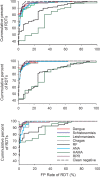An assessment of false positive rates for malaria rapid diagnostic tests caused by non-Plasmodium infectious agents and immunological factors
- PMID: 29758050
- PMCID: PMC5951549
- DOI: 10.1371/journal.pone.0197395
An assessment of false positive rates for malaria rapid diagnostic tests caused by non-Plasmodium infectious agents and immunological factors
Abstract
Background: Malaria rapid diagnostic tests (RDTs) can produce false positive (FP) results in patients with human African trypanosomiasis and rheumatoid factor (RF), but specificity against other infectious agents and immunological factors is largely unknown. Low diagnostic specificity caused by cross-reactivity may lead to over-estimates of the number of malaria cases and over-use of antimalarial drugs, at the cost of not diagnosing and treating the true underlying condition.
Methods: Data from the WHO Malaria RDT Product Testing Programme was analysed to assess FP rates of 221 RDTs against four infectious agents (Chagas, dengue, Leishmaniasis and Schistosomiasis) and four immunological factors (anti-nuclear antibody, human anti-mouse antibody (HAMA), RF and rapid plasma regain). Only RDTs with a FP rate against clean negative samples less than 10% were included. Paired t-tests were used to compare product-specific FP rates on clean negative samples and samples containing non-Plasmodium infectious agents and immunological factors.
Results: Forty (18%) RDTs showed no FP results against any tested infectious agent or immunological factor. In the remaining RDTs significant and clinically relevant increases in FP rates were observed for samples containing HAMA and RF (P<0.001). There were significant correlations between product-matched FP rates for RF and HAMA on all RDT test bands (P<0.001), and FP rates for each infectious agent and immunological factor were also correlated between test bands of combination RDTs (P≤0.002).
Conclusions: False positive results against non-Plasmodium infectious agents and immunological factors does not appear to be a universal property of malaria RDTs. However, since many malaria RDTs have elevated FP rates against HAMA and RF positive samples practitioners may need to consider the possibility of false positive results for malaria in patients with conditions that stimulate HAMA or RF.
Conflict of interest statement
Figures
References
-
- World Health Organization. World malaria report 2017. Geneva: 2017.
-
- Gillet P, Mumba Ngoyi D, Lukuka A, Kande V, Atua B, van Griensven J, et al. False positivity of non-targeted infections in malaria rapid diagnostic tests: the case of human african trypanosomiasis. PLoS Negl Trop Dis. 2013;7(4):e2180 doi: 10.1371/journal.pntd.0002180 ; PubMed Central PMCID: PMCPMC3636101. - DOI - PMC - PubMed
-
- Leshem E, Keller N, Guthman D, Grossman T, Solomon M, Marva E, et al. False-positive Plasmodium falciparum histidine-rich protein 2 immunocapture assay results for acute schistosomiasis caused by Schistosoma mekongi. Journal of Clinical Microbiology. 2011;49(6):2331–2. doi: 10.1128/JCM.00307-11 - DOI - PMC - PubMed
-
- Andreoli A, Giorgetti PF, Pietra V, Melzani A, Seni W, Castelli F, et al. Evaluation of a PfHRP-2 based rapid diagnostic test versus microscopy method among HIV-positive and unknown serology patients in Ouagadougou, Burkina Faso. Am J Trop Med Hyg. 2015;92(4):834–7. doi: 10.4269/ajtmh.13-0757 ; PubMed Central PMCID: PMCPMC4385783. - DOI - PMC - PubMed
Publication types
MeSH terms
Substances
Grants and funding
LinkOut - more resources
Full Text Sources
Other Literature Sources
Medical


